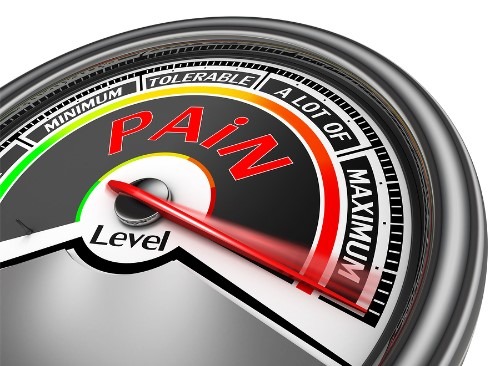How To Test Your Pain Tolerance At Home
Pain is an essential office of life. We are all going to experience it and nosotros all have our ain unique human relationship with pain. Do you have a loftier pain threshold or a low pain threshold or is there even such a thing?
We've all heard the clichés. Women accept a higher pain threshold than men. If men had to give birth the human race wouldn't survive. "Man influenza", "stiff upper lip", "grin and acquit it". Simply is there any science behind all this and what is the answer to the question that I get asked quite a lot.
Who has a improve pain threshold, women or men?

What is pain anyway?
Hurting is an experience and all pain happens in the encephalon. Pain is a response of the brain to all the information the encephalon has bachelor to it including everything it sees, hears, has read or experienced earlier. Hurting is a subjective thing and very difficult to measure. We've all experienced it, yet how tin can yous describe it and quantify it. How do you explain what a banana tastes like? Y'all know what it tastes like because you've probably had a few in your time but how do you explicate that to someone who never had one or how practice you know if someone else tastes the same thing as yous when they have a banana.
Pain is therefore calibrated individually. You measure your pain based on your ain experiences of previous painful episodes and rated it higher or lower to that.
How do you measure pain?

The simplest method and most commonly used is the Visual Analogue Scale. (VAS). You are asked to rate your pain between 0 (No pain at all) and 10 (Worst pain imaginable). Almost people, believe it or non will say 7. As a clinician what matters is that this number changes with treatment rather than how high or low the number is initially.
At that place are numerous validated questionnaires that look at the bear upon of hurting on a detail condition for case The Knee injury and Osteoarthritis Issue Score (KOOS) and endeavour to measure it that style.
Pain studies will use methods to stimulate pain such equally pressure level devices, temperature (really cold probes) or electric currents to subjects and see how long or how high someone tin sustain the stimulus before withdrawing and rating the pain on a VAS.
It's difficult to know if such studies truly measure pain every bit you have to wonder about the individuals who volunteer for a hurting experiment and are they really representative of the population as a whole?
What else influences hurting?

There are many factors that influence hurting but possibly the most of import is the circumstance, relevance or context of that hurting to that individual. For example a jockey who falls off a racehorse at 43 miles per 60 minutes and breaks their leg or dislocates their shoulder is delighted non to be paralyzed so they will probably rate the pain of that injury lower than mayhap if they broke their leg playing football.
Similarly someone who experiences their beginning episode of back pain might rate that higher than they would if they had back pain before and recovered from it. Think also of the individual who starts to get hurting in their hip and everyone in their family unit before them such as their mother, male parent, granny, uncle etc. etc. had a hip replacement. Well so it's natural for them to first to recall that this hip pain means they're on their mode to a hip replacement. That will cause college stress and anxiety levels which will increase their pain score. An other individual who doesn't accept whatever family history or feel of hip pain might pay no attention to it at all.
So, is in that location a difference between men and women?

We're getting into dangerous territory at present just it would appear that there is so allow's wait at what the science shows.
- Differences between men and women when it comes to hurting involve anatomical, physiological, neural, hormonal, psychological, social and cultural factors. When examining those factors, it is plant that women report pain more frequently, and have a lower threshold for pain than men. They unremarkably complain more than of musculoskeletal, neuropathic, electrical daze and temperature-related pain, but reply improve to opioids for hurting relief.
- A survey from the U.s.a. National Centre for Health statistics showed that more women (27.1%) than men (24.four%) reported that they were in pain.
- Numerous studies have shown that women tolerate lower thresholds of diverse painful stimuli than men in experimental groups.
- The female reproductive hormone estrogen has a role in some pain conditions such every bit migraine and temperomandibular joint disorder. Information technology is thought that Epinephrine stimulates pain nerve fibres in the body and men are more than sensitive to epinephrine than women. Estrogen appears to cause an increment in baseline plasma levels of epinephrine in women (up to twice as much every bit men) resulting in hyper-sensitivity of these pain nerves. Animal studies that remove the glands that produce estrogen prove reduced sensitivity of these nerves and increased pain tolerances in women which are reversed when estrogen is reintroduced.
- There are gender differences to the analgesic responses to sure stimuli in women versus men. For example women had a better analgesic effect from exercise than men did. Women also responded amend to opioid medication than men in treating their pain.
The volume of work into this area is vast. If you lot're curious to find out more this study of 11,000 patients and pain reporting in a hospital in the United States makes for some interesting reading.
https://www.ncbi.nlm.nih.gov/pmc/articles/PMC3293998/#S8title
And so what does that all mean?
What is very interesting is that women are often treated differently than men when it comes to pain by the medical profession.
- A survey of over 300 nurses believed that women were less sensitive to pain, more tolerant of pain, less distressed every bit a issue of pain, more than likely to report hurting and limited hurting through non verbal gestures. Yet the research says that women have lower thresholds for hurting tolerance in experimental studies and will experience greater and longer lasting pain.
- Women were more than likely to be prescribed sedatives for their pain and men analgesics yet the evidence says that women reply better to opioids when it comes to hurting relief. However it must exist noted that long term opioid employ can lead to hyperalgesia (increased pain sensitivity in the long run).
- Gender, cultural and social biases consequence in women's self reported accounts of hurting being discounted until in that location is objective evidence for the pain.
Here's an interesting article on the upstanding issues of treating pain in men and women.
https://digitalcommons.police.umaryland.edu/cgi/viewcontent.cgi?article=1144&context=fac_pubs
For what information technology'south worth
My own personal view is that it all depends on the individual. As physiotherapists we see people primarily with musculoskeletal hurting. The pain experienced with any injury is adamant by so many factors including physical, psychological, social, economical, age, experience, cultural factors and more that it isn't as simple every bit having a high or depression hurting threshold or if i person deals with information technology better than another. Information technology's all relative to that person at that moment in time and the parameters that influence pain change all the time. It's up to the physio treating the problem to aid guide yous through that process and discover which factors play a bigger or lesser part in your pain experience at any moment in time.
Subscribe to our Newsletter
Source: https://spinalphysio.co.uk/do-you-have-a-high-pain-threshold/

0 Response to "How To Test Your Pain Tolerance At Home"
Post a Comment